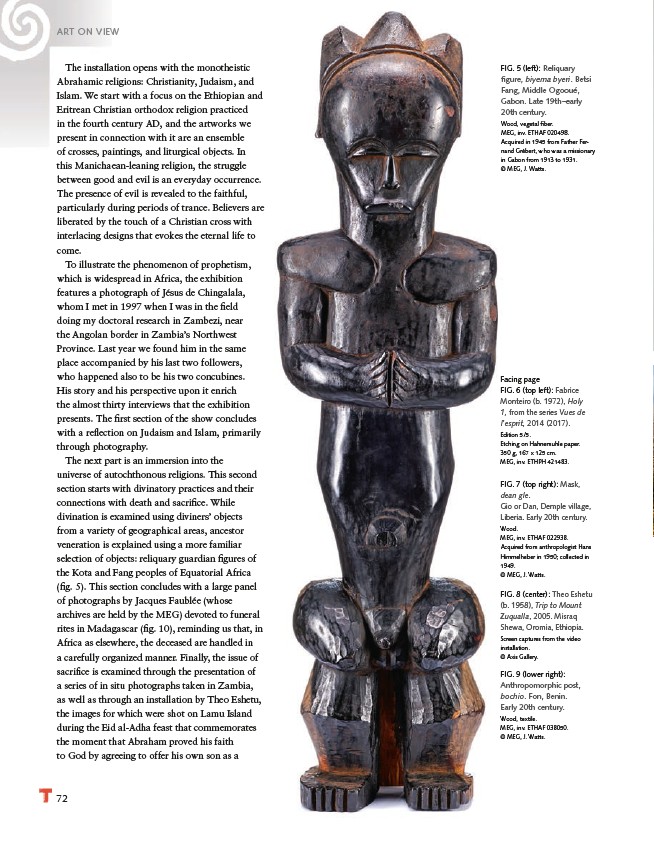
ART ON VIEW
The installation opens with the monotheistic
Abrahamic religions: Christianity, Judaism, and
Islam. We start with a focus on the Ethiopian and
Eritrean Christian orthodox religion practiced
in the fourth century AD, and the artworks we
present in connection with it are an ensemble
of crosses, paintings, and liturgical objects. In
this Manichaean-leaning religion, the struggle
between good and evil is an everyday occurrence.
The presence of evil is revealed to the faithful,
particularly during periods of trance. Believers are
liberated by the touch of a Christian cross with
interlacing designs that evokes the eternal life to
come.
To illustrate the phenomenon of prophetism,
which is widespread in Africa, the exhibition
features a photograph of Jésus de Chingalala,
whom I met in 1997 when I was in the fi eld
doing my doctoral research in Zambezi, near
the Angolan border in Zambia’s Northwest
Province. Last year we found him in the same
place accompanied by his last two followers,
who happened also to be his two concubines.
His story and his perspective upon it enrich
the almost thirty interviews that the exhibition
presents. The fi rst section of the show concludes
with a refl ection on Judaism and Islam, primarily
through photography.
The next part is an immersion into the
universe of autochthonous religions. This second
section starts with divinatory practices and their
connections with death and sacrifi ce. While
divination is examined using diviners’ objects
from a variety of geographical areas, ancestor
veneration is explained using a more familiar
selection of objects: reliquary guardian fi gures of
the Kota and Fang peoples of Equatorial Africa
(fi g. 5). This section concludes with a large panel
of photographs by Jacques Faublée (whose
archives are held by the MEG) devoted to funeral
rites in Madagascar (fi g. 10), reminding us that, in
Africa as elsewhere, the deceased are handled in
a carefully organized manner. Finally, the issue of
sacrifi ce is examined through the presentation of
a series of in situ photographs taken in Zambia,
as well as through an installation by Theo Eshetu,
the images for which were shot on Lamu Island
during the Eid al-Adha feast that commemorates
the moment that Abraham proved his faith
to God by agreeing to offer his own son as a
72
FIG. 5 (left): Reliquary
fi gure, biyema byeri. Betsi
Fang, Middle Ogooué,
Gabon. Late 19th–early
20th century.
Wood, vegetal fi ber.
MEG, inv. ETHAF 020498.
Acquired in 1945 from Father Fernand
Grébert, who was a missionary
in Gabon from 1913 to 1931.
© MEG, J. Watts.
Facing page
FIG. 6 (top left): Fabrice
Monteiro (b. 1972), Holy
1, from the series Vues de
l’esprit, 2014 (2017).
Édition 5/5.
Etching on Hahnemuhle paper.
350 g, 167 x 125 cm.
MEG, inv. ETHPH 421483.
FIG. 7 (top right): Mask,
dean gle.
Gio or Dan, Demple village,
Liberia. Early 20th century.
Wood.
MEG, inv. ETHAF 022938.
Acquired from anthropologist Hans
Himmelheber in 1950; collected in
1949.
© MEG, J. Watts.
FIG. 8 (center): Theo Eshetu
(b. 1958), Trip to Mount
Zuqualla, 2005. Misraq
Shewa, Oromia, Ethiopia.
Screen captures from the video
installation.
© Axis Gallery.
FIG. 9 (lower right):
Anthropomorphic post,
bochio. Fon, Benin.
Early 20th century.
Wood, textile.
MEG, inv. ETHAF 038050.
© MEG, J. Watts.